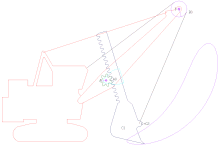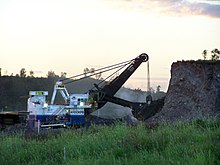
Excavators are heavy construction equipment primarily consisting of a boom, dipper, bucket and cab on a rotating platform known as the "house" - although the largest form ever, the dragline excavator, eliminated the dipper in favor of a line and winch.
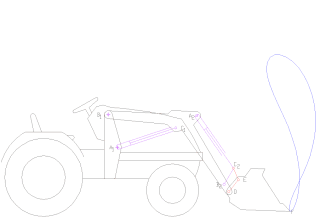
A loader is a heavy equipment machine used in construction to move or load materials such as soil, rock, sand, demolition debris, etc. into or onto another type of machinery.

A backhoe—also called rear actor or back actor—is a type of excavating equipment, or digger, consisting of a digging bucket on the end of a two-part articulated arm. It is typically mounted on the back of a tractor or front loader, the latter forming a "backhoe loader". The section of the arm closest to the vehicle is known as the boom, while the section that carries the bucket is known as the dipper, both terms derived from steam shovels. The boom, which is the long piece of the backhoe arm attached to the tractor through a pivot called the king-post, is located closest to the cab. It allows the arm to pivot left and right, typically through a range of 180 to 200 degrees, and also enables lifting and lowering movements.
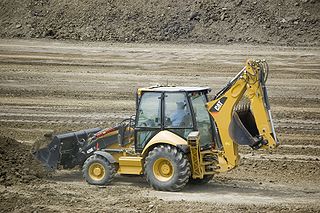
A backhoe loader, also called a loader backhoe, loader excavator, tractor excavator, digger or colloquially shortened to backhoe within the industry, is a heavy equipment vehicle that consists of a tractor-like unit fitted with a loader-style shovel/bucket on the front and a backhoe on the back. Due to its (relatively) small size and versatility, backhoe loaders are very common in urban engineering and small construction projects as well as developing countries. This type of machine is similar to and derived from what is now known as a TLB (Tractor-Loader-Backhoe), which is to say, an agricultural tractor fitted with a front loader and rear backhoe attachment.

Heavy equipment, heavy machinery, earthmovers, construction vehicles, or construction equipment, refers to heavy-duty vehicles specially designed to execute construction tasks, most frequently involving earthwork operations or other large construction tasks. Heavy equipment usually comprises five equipment systems: the implement, traction, structure, power train, and control/information.

A dragline excavator is a heavy-duty excavator used in civil engineering and surface mining. It was invented in 1904, and presented an immediate challenge to the steam shovel (and its diesel and electric powered descendant, the power shovel. Much more efficient than even the largest of the latter, it enjoyed a heyday in extreme size for most of the 20th century, first becoming challenged by the more efficient yet rotary excavators in the 1950s, then superseded by them on the upper end from the 1970s on.

A steam shovel is a large steam-powered excavating machine designed for lifting and moving material such as rock and soil. It is the earliest type of power shovel or excavator. Steam shovels played a major role in public works in the 19th and early 20th century, being key to the construction of railroads and the Panama Canal. The development of simpler, cheaper diesel, gasoline and electric shovels caused steam shovels to fall out of favor in the 1930s.

Big Brutus is the nickname of the Bucyrus-Erie model 1850-B electric shovel, which was the second largest of its type in operation in the 1960s and 1970s. Big Brutus is the centerpiece of a mining museum in West Mineral, Kansas, United States where it was used in coal strip mining operations. The shovel was designed to dig from 20 to 69 feet down to unearth relatively shallow coal seams, which would themselves be mined with smaller equipment.
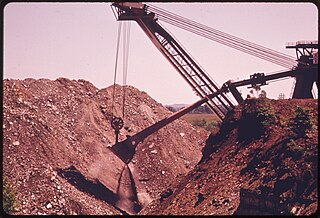
The Silver Spade was a giant power shovel used for strip mining in southeastern Ohio. Manufactured by Bucyrus-Erie, South Milwaukee, Wisconsin, the model 1950-B was one of two of this model built, the other being the GEM of Egypt. Its sole function was to remove the earth and rock overburden from the coal seam. Attempts to purchase and preserve the shovel from Consol to make it the centerpiece of a mining museum exhibit for $2.6 million fell short, and the shovel was dismantled in February 2007.

A bucket-wheel excavator (BWE) is a large heavy equipment machine used in surface mining.

Marion Power Shovel Company was an American firm that designed, manufactured and sold steam shovels, power shovels, blast hole drills, excavators, and dragline excavators for use in the construction and mining industries. The company was a major supplier of steam shovels for the construction of the Panama Canal. The company also built the two crawler-transporters used by NASA for transporting the Saturn V rocket and later the Space Shuttle to their launch pads. The company's shovels played a major role in excavation for Hoover Dam, the Holland Tunnel and the extension of the Number 7 subway line to Main Street in Flushing, Queens.

Big Muskie dragline excavator built by Bucyrus-Erie and owned by the Central Ohio Coal Company, weighing 13,500 short tons (12,200 t) and standing nearly 22 stories tall. It mined coal in the U.S. state of Ohio from 1969 to 1991, and demolished and sold for scrap in 1999.
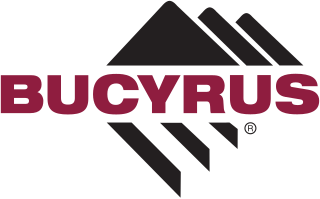
Bucyrus-Erie was an American surface and underground mining equipment company. It was founded as Bucyrus Foundry and Manufacturing Company in Bucyrus, Ohio, in 1880. Bucyrus moved its headquarters to South Milwaukee, Wisconsin in 1893. In 1927, Bucyrus merged with the Erie Steam Shovel Company to form Bucyrus-Erie. In 1997, it was renamed Bucyrus International, Inc.. In 2010 the enterprise was purchased by Caterpillar in a US$7.6 billion transaction that closed on July 8, 2011. At the time of its acquisition, the Bucyrus product line included a range of material removal and material handling products used in both surface and underground mining.
The Osgood Company was a Marion, Ohio based manufacturer of heavy machinery, producing steam shovels, dragline excavators and cranes. What would eventually become Osgood Company was founded in 1910 as Marion Steam Shovel and Dredge Company by A.E. Cheney, the former head of sales for the Marion Steam Shovel Company. Marion Power Shovel acquired Osgood Company in 1954 and integrated Osgood's products into the Marion Power Shovel product line.
Marion 6360, also known as The Captain, was a giant power shovel built by the Marion Power Shovel company. Completed in 1965, it was one of the largest land vehicles ever built, exceeded only by some dragline and bucket-wheel excavators. The shovel originally started work with Southwestern Illinois Coal Corporation, but the owners were soon bought out by Arch Coal. Everything remained the same at the mine except for the colors which were changed to red, white, and blue.

The Ursa Major at Black Thunder Coal Mine, Wyoming, is the largest dragline excavator currently in use in North America and the third largest ever built. It is a Bucyrus-Erie 2570WS model and cost US$50 million. The Ursa Major was one of five large walking draglines operated at Black Thunder, with the next two largest in the dragline fleet being Thor, a B-E 1570W - which has a 97.5-metre (320 ft) boom and a 69-cubic-metre (2,400 cu ft) bucket - and Walking Stick, a B-E 1300W with a 92-metre (302 ft) boom and a 34-cubic-metre (1,200 cu ft) bucket.

P&H Mining Equipment sells drilling and material handling machinery under the "P&H" trademark. The firm is an operating subsidiary of Joy Global Inc. In 2017 Joy Global Inc. was acquired by Komatsu Limited of Tokyo, Japan, and is now known as Komatsu Mining Corporation and operates as a subsidiary of Komatsu.
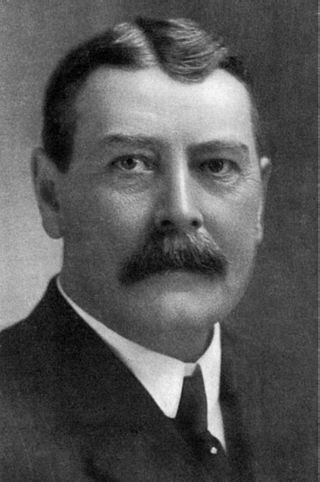
Joy Global Inc. was a company that manufactured and serviced heavy equipment used in the extraction and haulage of coal and minerals in both underground and surface mining. The company had manufacturing facilities in Alabama, Pennsylvania, Texas, Wisconsin, Australia, Canada, China, France, South Africa, Poland and the United Kingdom. In 2017, Joy Global was acquired by Komatsu Limited and was renamed Komatsu Mining Corp.

The GEM of Egypt was a power shovel used for strip mining built by Bucyrus-Erie in 1966 for working the Egypt Valley coalfield near Barnesville, Ohio. GEM is an acronym for “Giant Earth Mover” or “Giant Excavating Machine”. It was one of only two Bucyrus-Erie 1950-B shovels built and one of two to use the knee action crowd, licensed from Marion Power Shovel in exchange to Marion's use of BE's cable crowd patent.

A bucket chain excavator (BCE) is a piece of heavy equipment used in surface mining and dredging. BCEs use buckets on a revolving chain to remove large quantities of material. They are similar to bucket-wheel excavators and trenchers. Bucket chain excavators remove material from below their plane of movement, which is useful if the pit floor is unstable or underwater.
